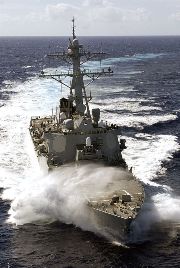by Tech. Sgt. Harry Kibbe
376th Air Expeditionary Wing
MANAS AIR BASE, Kyrgyzstan (March 20, 2009) - "Any aircraft, any station, this is Shell 73, Emergency. We’ve lost complete navigational capability. Request assistance."
This was the mayday call from Capt. Matthew Jaeger as he and the crew of Shell 73, a KC-135 Stratotanker from Manas Air Base, Kyrgyzstan, blindly transmitted as it flew somewhere over the border of Kyrgyzstan and Tajikistan.
As luck would have it, Capt. Jaeger was on the 13th flight of his first deployment as an aircraft commander when both of his flight navigation systems failed, leaving the pilot of just more than two years unsure of where his current path would take his crew and plane.
"We were trying to diagnose the problem the entire time, going through our checklists, but nothing we did was solving it," said Captain Jaeger.
To make matters worse, all geographic landmarks below were hidden by heavy cloud cover, so the crew couldn’t rely on visual references to guide them back to Manas or to an alternate landing site. Even if they had been able to steer themselves home, poor weather conditions prevented them from landing at Manas, where the airfield was socked in by rain and clouds.
"I remembered the basics," said Jaeger, "Aviate, navigate, communicate…we had plenty of fuel, and we knew that our altitude was high enough to keep us safely above the mountainous terrain."
Realizing that landing at Manas was out of the question, Jaeger decided to divert Shell 73 south towards Afghanistan, knowing that he had to be particularly careful to not enter Chinese or Iranian air space.
"I knew that the weather was good at Bagram from our mission brief," he said. "We had to land at a field where we could use visual flight rules; one where we could see the runway and manually input our landing data."
Flying on standby instruments, Captain Jaeger had to think on his toes - quickly. He told the boom operator, Senior Airman McKayla Dick, to grab the handheld GPS out of the aircraft survival kit.
"My whole mentality was just to stay calm," said Airman Dick. "I had to help out as much as I could so that we could get out of this situation."
The move by Jaeger to use the handheld GPS garnered great admiration from those in his chain of command.
"In my experience, something like this has never happened before," said Lt. Col. Patrick Rhatigan, 22nd Expeditionary Air Refueling Squadron commander, who has 18 years of experience as a pilot. "For him to pull out the handheld GPS shows a level of maturity and quick thinking not usually seen in junior aircraft commanders."
The out-of the box thinking worked. The crew used the GPS to verify they were on a heading to cross the border into Afghanistan, where they would be able to call for support from coalition aircraft.
"For about five minutes it was pretty tense, but once I knew we were on a vector south toward Afghanistan, that’s when it started to calm down," said 1st Lt. Vance Feavel, copilot of Shell 73 who like the rest of the crew, is deployed from the 92nd Air Refueling Squadron at Fairchild Air Force Base, Wash.
Now in Afghanistan, and within contact range of Kabul Air Control, Capt Jaeger was able to issue the mayday call.
"We contacted Kabul, explained our situation and gave our position using the GPS," explained Jaeger. "We then asked for a relay to see if we could get another plane to rendezvous with us."
Not far away, Moose 75, a C-17 deployed out of the 16th Airlift Squadron from Charleston AFB, S.C., was on an airdrop mission when they heard the call and diverted to intercept Shell 73.
"Judy, I gotcha!" called out Lieutenant Feavel as he established visual confirmation with the C-17 just twenty minutes after the first mayday call.
Moose 75 was then able to lead Jaeger and his crew to Bagram Airfield, Afghanistan, where they set up a holding pattern.
"Bagram is basically in a bowl of mountains," said Jaeger. "Moose 75 was able to take us into a holding pattern and then lead us through a hole in the clouds before guiding our descent for a visual approach."
"It was a relief to know that we were able land safely with the help of Moose 75 and Kabul Air Control," said Feavel after the crew of Shell 73 was back on the ground.
Once at Bagram, the crew's fortunes continued. The transient alert contractors that marshaled them to their parking spot were both former KC-135 crew chiefs. They responded immediately, checking out the navigational systems onboard. After successfully rebooting the systems and finding nothing wrong, Shell 73 started up for the flight back to Manas.
After just three hours on the ground at Bagram, Jaeger and his crew were airborne and Shell 73 was navigating its way back home.
Once back to Manas, the crew got a good night's rest and were back on the flying schedule the following day, flying yet another refueling mission over Afghanistan.
"We got back without any real issues," said Jaeger. "It was a real learning experience, but we couldn’t have done it without the help we were fortunate to receive from the C-17 crew and those on the ground."
"As a pilot who's flown the C-17 and KC-135, I'm really proud of how both crews teamed up, relied on their training, and pulled the rabbit out of the hat to keep us off the front page news," said Rhatigan. "The outcome is a real testimony to the level-headed professionals carrying out the mission in the air and on the ground."
Source: CENTCOM.
Cross-posted @ Rosemary's News and Ideas.
Friday, March 20, 2009
Subscribe to:
Post Comments (Atom)
















No comments:
Post a Comment
Please be respectful of others, so they may be respectful to you. Have a blessed day.